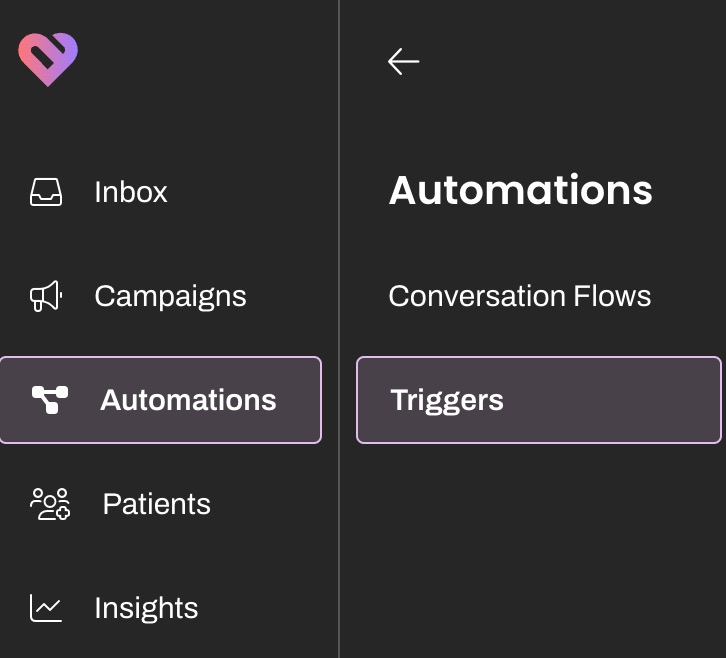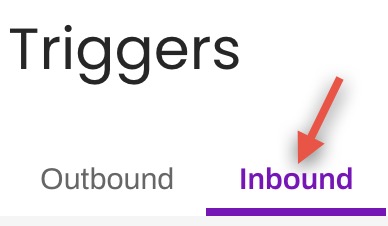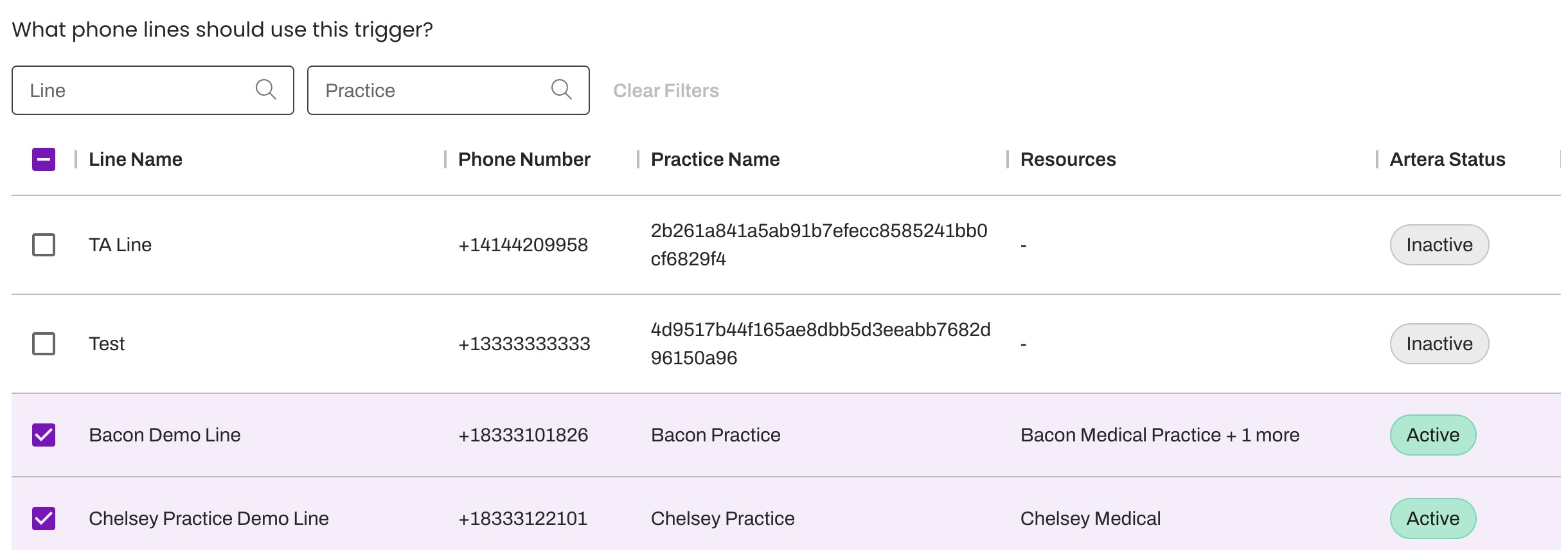Triggers - Inbound Messages
- Get Started
- Release Notes
- Triggers
- Patient Channel
- Troubleshooting and FAQ
- Patient Facesheet
- Technical Specifications
- Insights & Analytics
- Inbox
- Conversation Flows
- Campaigns
- Lines & Resources Requests
- Lines, Events, Resources
- SMS Basics
- Automations
- Referrals
- AI Agents
- Add-Ons
- Users and Groups
- Platform Settings and Configuration
- Self-Rescheduling
- Recalls
- Marketplace
- Artera Harmony Federal Edition
Table of Contents
Page Overview Configure Inbound Message Trigger Choose LinesKeyword SelectionSelect Automated ActionMultiple Action SupportConversation FlowsManaging Inbound Message TriggersFAQsPage Overview
Inbound Message Triggers allow Enterprises to set up automated responses or other key actions, such as close a Patient Channel, when a patient messages into a Practice. Inbound Message Triggers can be built based on Practice specifications, like Events, providers, locations, and lines.

- Outbound and Inbound: Toggle between the Outbound and Inbound Triggers pages.
-
Conversation Details
- Name: This is established when creating the Inbound Trigger and serves as its title.
- Last Updated: This will display the last date and time the Inbound Trigger was updated.
- Trigger: This identifies whether the keyword sent by the patient needs to be in response to a confirmation message (response to confirmation) or not (response to any message).
- Practices: This displays the total number of Practices configured to use this Inbound Trigger.
- Lines: These are the lines that use this Inbound Trigger.
- Keywords: This displays the total number of words and phrases set up as keywords for this Trigger. These items will trigger the Inbound action when received from the patient.
- Actions: This indicates the associated action the keyword will trigger.
- Hours: This indicates when the Inbound Trigger will take action.
- Method: The icons display which message types the Inbound Message Trigger will send, if the action chosen is to "Send Response to Patient" or "Create Mention". This includes text, call, and/or email.
- Secure: This indicates whether the auto-resposne back to the patient will be sent as a secure message (lock icon).
- Status: This indicates if the Inbound Trigger is on or off.
- Message: Click this link to preview the text, phone, or email message content if an auto-response is being sent to the patient. This does not display any translations added to Inbound Triggers that prompt a response back to the patient.
- Actions: Selecting the three-dot menu will allow you to Turn On/Off, Edit, Duplicate, or Delete the Inbound Trigger.
-
Search Filters: Filter the Triggers page to locate Inbound Message Triggers by Name, Practice, Line, or Keywords.
NOTE: Only one filter in each category can be applied at once. - Create New: Select this button to create a new Inbound Message Trigger.
- Bulk Actions: Select this button to turn Triggers on/off in bulk, saving you time and effort.
- Rows per page: Select how many Triggers per page you would like to see. Each Trigger will appear in a row.
Configure Inbound Message Trigger
-
From the Navigation Bar, select Automations > Triggers.

-
Select the Inbound tab.

- Select Create New in the top-right corner.

- Add a Trigger Name. This will serve as the Inbound Message Trigger's title, so be sure to use consistent naming conventions.
-
Select the Module drop-down menu and select the type of message that will prompt the Trigger to activate. View the videos below for more information.
- Respond to any Message: This is a broader option that will prompt the Inbound Message Trigger based on any patient inbound message that matches a keyword configured as part of the Trigger itself.
-
Respond to Confirmation Message: This option allows the Inbound Message Trigger to be prompted only if a patient responds to a message that contains one of the following Smart Phrases:
- {eventConfirmText}
- {eventConfirmLink}

NOTE: As you progress through each step, the Details panel on the right-hand side will update with the Inbound Message Trigger's information.
Choose Lines
From the What phone lines should use this Trigger? step, select the line(s) that will prompt the Inbound Message Trigger by choosing the box near each Line.
TIP: To bulk select lines, use the check box located to the left of "Line Name."

Keyword Selection
Next, include each keyword or short phrase that will prompt the Inbound Message Trigger's Action. To do this, select the + Add Criteria link.

Exact Match vs. Contains
With the Exact Match option, the Inbound Message Trigger will only be prompted if the patient sends a message that includes the word(s) exactly as entered into the text box. Case is ignored, but the order of the words and punctuation are respected. This allows you to be highly selective with the patient responses that will prompt the desired Action.
Enter each keyword and/or phrase, then hit the "enter" key on your keyboard to add the keyword criteria. Continue this process until you have captured all the relevant keywords. There is no limit on the amount of keywords you can enter.

For most keywords, we recommend using the Contains option. This allows the Inbound Message Trigger to scan the patient's inbound message for specific words. When using this option, you will be prompted to enter text length limits for the number of characters contained within the patient's message. If a patient's message falls outside the character limits, the Inbound Message Trigger will not be prompted.
It is important to note that the Contains function searches for whole keywords and will not prompt the Inbound Message Trigger based on a partial keyword or keyword phrase match. Let's review an example: if the keyword entered is "sounds good," the Inbound Message Trigger will not be prompted if the patient sends in "sounds cool," but will be prompted for "okay sounds good!"
We recommend using Less than criteria and 30 characters or less. By setting a relatively small character limit, you ensure that any lengthy patient message does not get overlooked as a result of the keyword action being prompted.

+ Add Additional Criteria
If you would like to capture both "Exact Match" and "Contains" criteria for keywords, select the + Add Additional Criteria button to add additional keywords using the new criteria option.
Select Trigger Action
Choose the desired action for the Inbound Message Trigger to take when a matching keyword is received.
The options available are slightly different depending on what you selected for the Conversation Module ("Respond to Any Message" or "Respond to Confirmation Message").
- Confirm Appointment (Confirmation Message only)
- Request to Reschedule Appointment (Confirmation Message only)
- Request to Cancel Appointment (Confirmation Message only)
- Create a Mention
- Send Response to Patient
- Open Channel
- Pend Channel
- Close Channel
Confirm Appointment, Request to Reschedule, Request to Cancel
This option is only available when the Inbound Message Trigger is set up to send in Response to a Confirmation Message.
Create a Mention
When you select this Action, you will add the desired users or User Groups to the Patient Channel using @groupname or @username. Then, you will need to include the custom message that will be sent to that user or User Group. Click here to learn about Internal Mentions.
NOTE: Only Enterprise Users can be tagged in an Internal Mention. If a Staff or Manager User needs to be tagged, add them to an Enterprise User Group and tag that User Group in the Patient Channel.

Send Response to Patient
Use this option to automatically message back the patient when one of the keywords is received. Craft your message and include text to respond to patients who text in or email to respond to patients who email in.

Media files can be included in this outbound message. This includes campus maps, PDF files with instructions, and more. We recommend all attached media is under 500KB in size to preserve performance. When using this Action, determine which Hours to Send the message:
- After Hours Only
- Business Hours only
- Always
NOTE: If you have an After-Hours Auto-Response set up for a Practice or a line, the patient will receive the Inbound Message Trigger response rather than the After-Hours Auto-Response as long as the patient's message meets the Trigger's criteria. If the message does not meet the Trigger's requirements, the patient will receive the After-Hours Auto-Response.
Quick Responses
Save time crafting your Appointment Trigger's message by leveraging your Enterprise's existing Default-level Quick Responses.

Open, Pend, or Close Channel
Choose these options to automatically update the status of the Patient's Channel.
Multiple Action Support
Artera supports one Action per Inbound Message Trigger. However, there are many Inbound Message Triggers that work best when paired with two or more Actions.
For example, if a patient texts in asking for the address to their appointment, you could format one Inbound Message Trigger to send a message back to the patient with the Location's address for their next appointment. You may also want to create another Inbound Message Trigger with the same keyword parameters that would automatically close the Patient's Channel so that Staff Users do not spend time manually closing the Patient Channel.
To simplify this process (and prevent the need to recreate the entire Inbound Message Trigger), use the (...) Actions menu for the Inbound Message Trigger you wish to duplicate and select Duplicate. Then, you will only need to update the Action and save.

Now, you have two Inbound Message Triggers that have the same keyword parameters and two different Actions. It is important to note that any Action that changes the Patient's Channel status will be the final Action taken. In this example, the message will be sent to the patient first and the Patient Channel closing will follow, regardless of the order in which the Inbound Message Triggers were created.
Conversation Flows
If you use Conversation Flows, you can set up a Conversation in Conversation Flows that will allow you to create one Inbound Message Trigger that has multiple Actions associated with it.
Managing Inbound Message Triggers
It is important to have an Inbound Message Trigger strategy to ensure that your Triggers stay up-to-date over time. Click here to learn more.
Editing a Conversation
As an Enterprise User, you can edit Inbound Message Triggers so that the Triggers are updated for all Practices that use them:
- Navigate to Triggers.
- Navigate to the Inbound tab
- Select the Trigger you wish to edit by selecting its three-dot Action menu on the right side and choose Edit.
- Change desired section.
- Select Update when done to save your changes.
FAQs
Will patients who message in during a Practice's after-hours receive the appropriate Inbound Message Trigger and the Practice's After-Hours Auto-Response?
No, if a patient triggers an Inbound Message Trigger during your Practice's after-hours, the Inbound Message will be sent to the patient instead of the the After-Hours Auto-Response. Click here to learn more about After-Hours Auto-Responses.
A few of our Practices use Artera solely for Appointment Reminders, not Conversational Messaging. How do we configure the necessary Inbound Message Triggers to automatically close all Patient Channels?
In the third step of the Inbound Message Trigger's configuration, be sure to leave the question of "What keywords or phrases should trigger this Conversation?" blank. Leaving this blank will cause the Inbound Message Trigger to activate based on any inbound message sent to the line.

